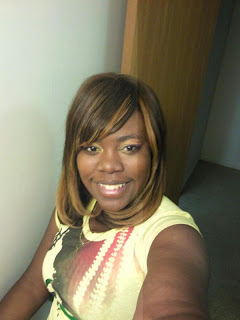 Glued in extension are a quick and easy way to put in extension for special occansion. You can use these typs of extension for adding a splash of color or longer pices even to fill in areas that are losing hair. Some different types of hair pieces that can be used are the basic glued in weft method, fusion or individual strands, and even toupees ( mens hair pieces). today we will be going over the basci weft mothod that can be used for some added length and fullness for a client. Unlike a sewn in weave you dont have to worry about all the braiding of the natural hair, on the other hand you do have to check and make sure your client is not allergic to the hair glue that you will be using. You can check if they are allergic by doing a skin test. When doing a skin test you will take a little bit of the glue and apply a little dot to the inside of the wrist or behind the ear and wait 5 minutes and see if there is any redness or your client experiences any itching. If so you may have to use a different type of glue or try another method of how to put the extension in the hair.
Glued in extension are a quick and easy way to put in extension for special occansion. You can use these typs of extension for adding a splash of color or longer pices even to fill in areas that are losing hair. Some different types of hair pieces that can be used are the basic glued in weft method, fusion or individual strands, and even toupees ( mens hair pieces). today we will be going over the basci weft mothod that can be used for some added length and fullness for a client. Unlike a sewn in weave you dont have to worry about all the braiding of the natural hair, on the other hand you do have to check and make sure your client is not allergic to the hair glue that you will be using. You can check if they are allergic by doing a skin test. When doing a skin test you will take a little bit of the glue and apply a little dot to the inside of the wrist or behind the ear and wait 5 minutes and see if there is any redness or your client experiences any itching. If so you may have to use a different type of glue or try another method of how to put the extension in the hair. Just like when we was talking about putting in a sewn in weave you want to take 1/2" sections and in a horizontal lines and measure the weft from end to end. Be careful that when you are measuring you dont go over the ends of the hair but you stay fairly close to the inside of the hair. You dont want the ends of the extensions to show over their natural hair. After you measure the length of the weft you want to apply a small amount of glue along the base of the weft where it is sewn together at. Where youhave sectioned the hair you will then apply the weft to the scalp from one end to the other end, pushing down the weft to make sure it is all on the scalp. Be carful that you dont attach the weft to the hair but to the scalp so it will be easier to remove the weft when you are ready to take it out. Hold the weft down tightly to the scalp for an=bout a minute running your fingers along the length of the weft. Do not pull or add any tension the the weft for at least 5 min so it can dry completely.
Follow up the head with the horizontal section applying the wefts inbetween each section to the hair. You want to keep going up the head to the crown area ( high point on the head). Determine if your client would like to stop there or add more hair to the top fo radded lenghth and body. No matter where you decide to stop you have to make sure you have enough hair to cover the wefts and blend it in so it looks as natural as possible. When you are ready to take the extensions out of the head do not judt start pulling them out you can use a hair glue remover, vasealine or any other cream based conditioner and massage the wefts by the scalp with the remover. This action allows you to loosen up the glue with out pulling out your natural hair. When you get the weft out of the hair take a comb and gently comb out any extra glue that might have been left in the hair. After you have gotten everything out of the hair you can wash the hair making sure you get everything out of the hair.









